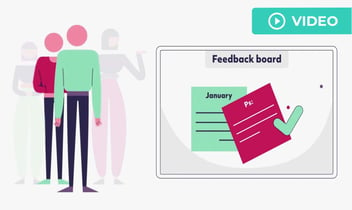Eight Proven Ways to Show Appreciation at Work

Your definitive guide on how to create a culture of gratitude in your company
As kids, thank you was one of the things we said most frequently. Those two little words and all the appreciation that came from them were the social glue holding it all together.
But as we grew up and started getting jobs, a strange thing happened. The harsh reality of adults hit us in the face: you can expect more gratitude from strangers than from your coworkers most of the time.
Now, psychologists and researchers are proving that's not the way things have to be.
So, read this article to learn all about gratitude and appreciation at work. You'll understand why you must show your thankfulness and start a culture of gratitude in your company.
Appreciation pays dividends, so I'm going to teach you how to be more heart-forward, even in the dog-eat-dog world of offices.
Let's begin.
What’s the meaning of it all
First things first: to understand appreciation, you must know about feedback.
In communication, feedback is information about reactions to things like a person's performance or action, and it's used as a basis for improvement.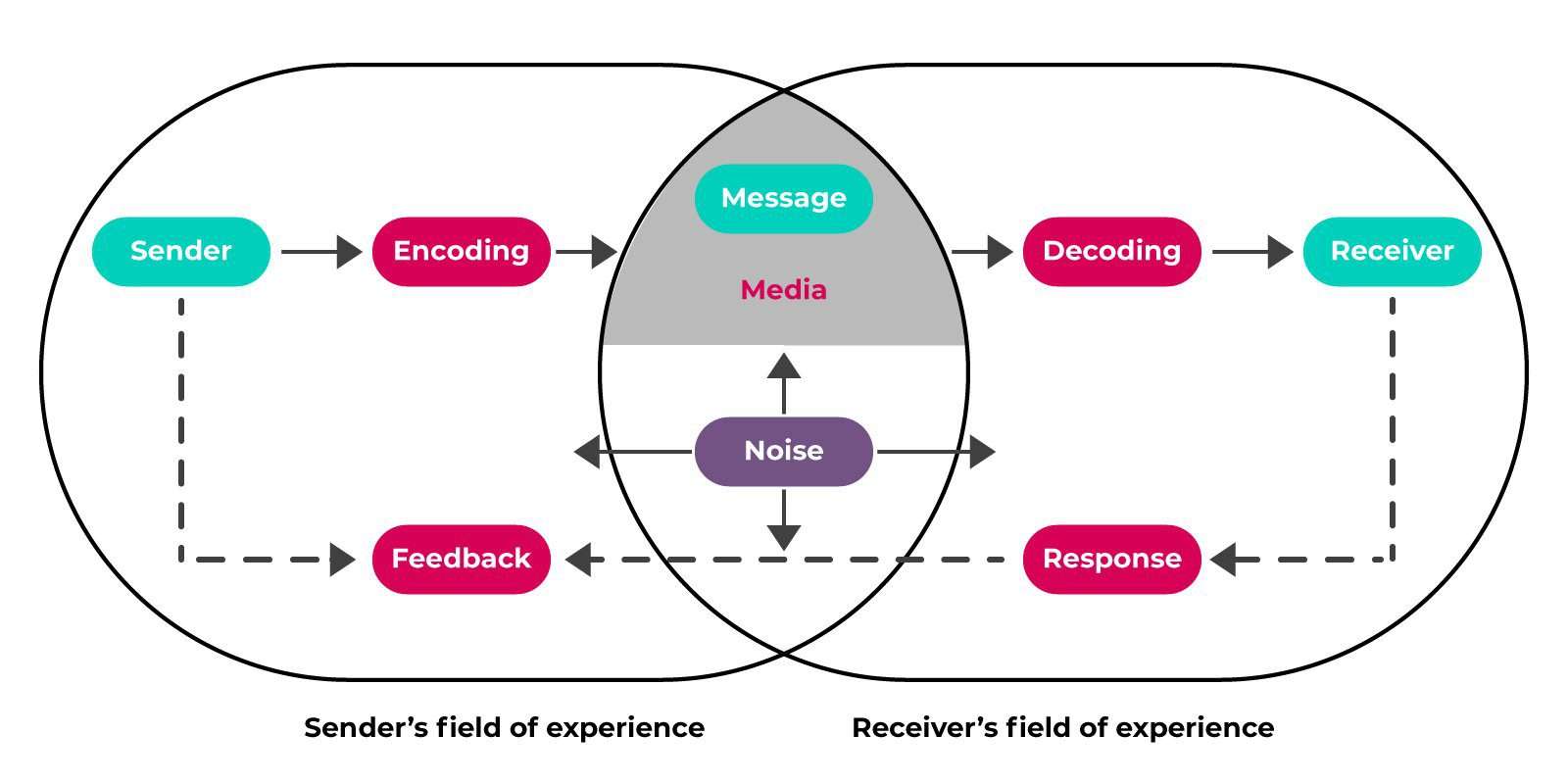
There are three types of feedback, and each one of them serves a different purpose:
- Evaluation is learning where you are compared to others or a standard. This kind of feedback is mostly used to align expectations and clarify consequences.
- Coaching guides you towards a better way of doing something. Done skillfully, it can help you improve your skills and grow as a person.
- Appreciation is all about giving thanks and recognizing an A-game. For it to be effective, it needs to be authentic, specific and delivered just right.
You can think of appreciation as acknowledging the value and meaning of something and feeling a positive emotional connection to it.
A close relative of appreciation is gratitude.
Gratitude is one of the almost 600 words in the English words used to express emotional experiences. Most of us have our understanding of it, but at its core, gratitude is the quality of being thankful.
If you’re a visual thinker, here’s a scheme of the interactive nature of gratitude: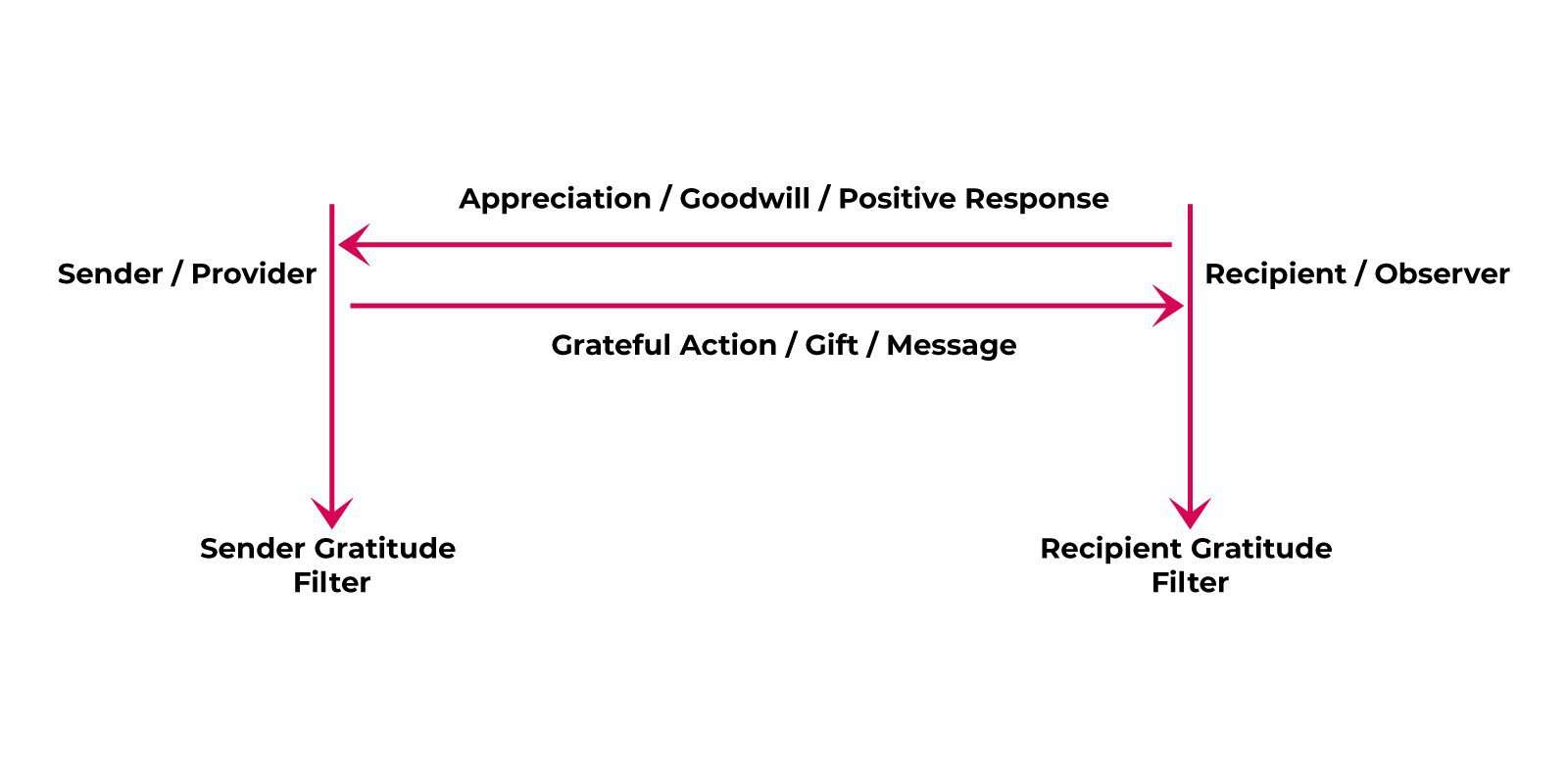
Robert Emmons, the world's leading scientific expert on gratitude, gives it a more in-depth, two-part definition:
“First, it's an affirmation of goodness. We affirm that there are good things in the world, gifts, and benefits we've received. This doesn't mean that life is perfect; it doesn't ignore complaints, burdens, and hassles. But when we look at life as a whole, gratitude encourages us to identify some amount of goodness in our life.
The second part of gratitude is figuring out where that goodness comes from. We recognize the sources of this goodness as being outside of ourselves. It didn't stem from anything we necessarily did ourselves in which we might take pride in. We can appreciate positive traits in ourselves, but I think true gratitude involves a humble dependence on others: We acknowledge that other people—or even higher powers, if you're of a spiritual mindset—gave us many gifts, big and small, to help us achieve the goodness in our lives.”
Robert Emmons in Why Gratitude Is Good
To simplify things, think of gratitude as a felt sense of wonder, thankfulness, and appreciation for life.
Now that we've got all our bases covered and we're on the same page about the definitions let's start our deep dive.
The trouble with appreciation at work
Even though appreciation is part of the feedback process, and you might expect it to be a staple in workplaces, it’s not the norm.
We all seem trapped in thankless concrete jungles because of the pervasive idea that, at work, everything is transactional. Your thank you is your paycheck, and you can’t expect anything else.
You must stay in your lane and don’t show any emotion. Don’t even attempt niceness; everyone knows that’s sucking up in disguise.
Research from The John Templeton Foundation backs this up with some sad findings: people are less likely to allow themselves to feel or express gratitude at work than anyplace else. And their job is dead last on their list of things they’re grateful for.
But it’s not like we stop being humans with a fundamental need to be seen and appreciated the minute we step into an office. Sure, we don’t just work out of the goodness of your heart, but trying to disconnect from our needs for eight hours a day only brings trouble.
The same study from Templeton shows that almost all participants reported that saying thank you to colleagues makes them feel happy and fulfilled. But, on a given day, only 10% acted on that impulse. Almost 60% said they either never express gratitude at work or do so perhaps once a year!
Ironically, 93% of them agreed that grateful bosses are more likely to succeed, and only 18% thought that gratitude made bosses “weak.” Most reported that getting a thank you at work made them feel good and motivated.
The conclusion? People actively suppress gratitude at work, even if it means robbing themselves of happiness.
Managers have it all wrong
As human beings, we're wired and primed for gratitude. And while everyone is thinking about how underappreciated they are, no one is willing to take the lead and express gratitude first.
The American Psychological Association discovered that more than half of the people looking for new jobs feel underappreciated and undervalued in their current position. They're also disappointed in the employee recognition practices their job has in place.
Gratitude is a topic researchers have visited time and time again, coming to the same sad conclusions: recognition isn't a thing in the workplace, despite all its benefits.
Kenneth A. Kovach is a professor of human resource management and labor relations. In one of his studies, he looked at staff members' and managers' perceptions of job reward factors.
His findings illustrate how much people crave appreciation and how little attention managers pay to it.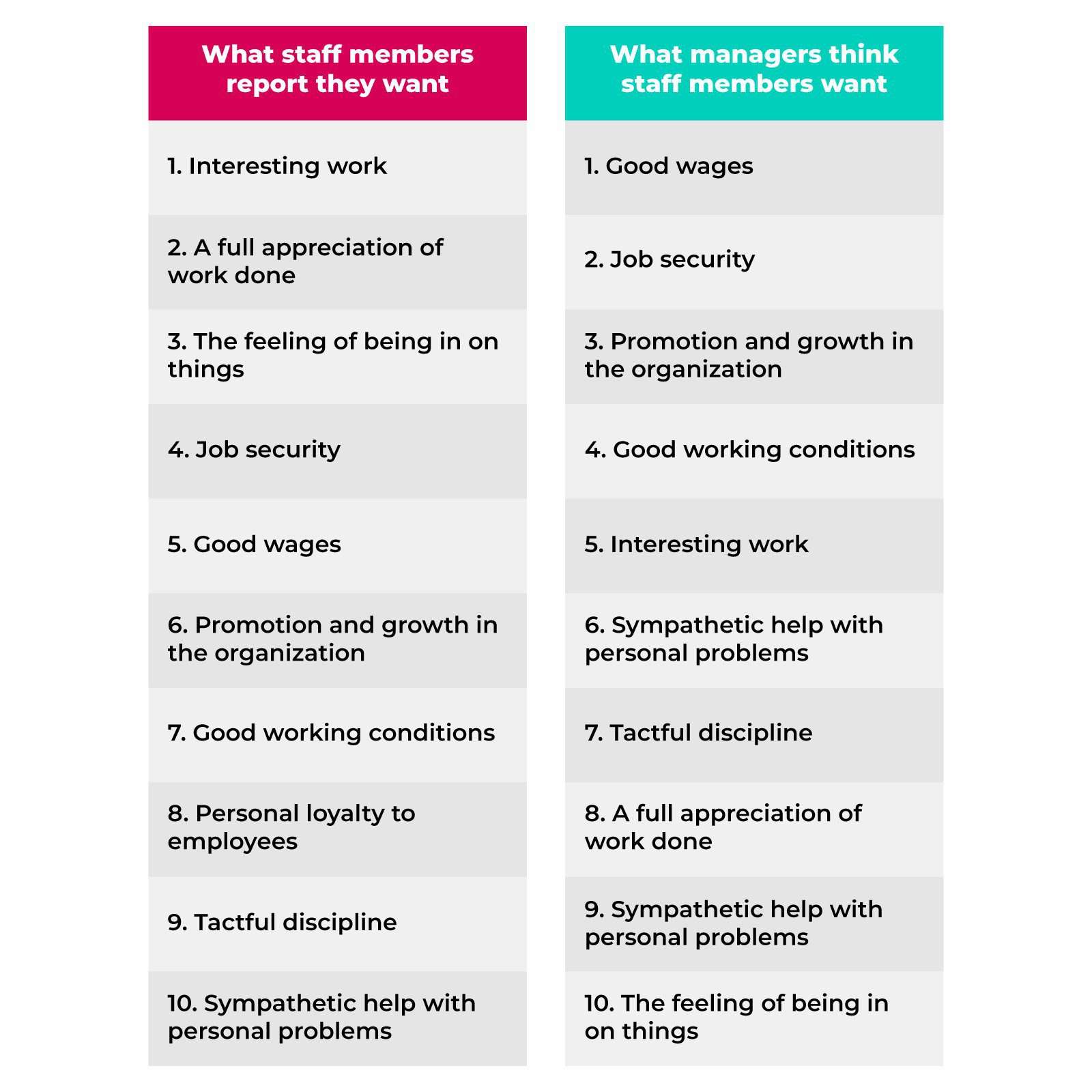
As you can see, appreciation is in the top 3 for people, but in the bottom 3 for managers.
Wondering what got us into this mess? You can partly blame it on the extrinsic incentive bias.
That's our incorrect belief that other people work for external gain (aka money), rather than intrinsic reasons, like building skills or being drawn to a task.
But there are other factors at play as well.
For example, it can be easy to measure the impact of a salary increase on productivity. This is something objective we can measure. But it's hard telling if the extra time you put into being helpful to your team is hitting any mark or having a positive impact. It's all intangible.
As a result, managers often underinvest in appreciation and gratitude.
Adam Grant is an American psychologist, teacher, researcher, and writer. He is a leading expert on how we can find motivation and meaning at work, and live more generous and creative lives. On Hurry Slowly, a podcast about pacing yourself, this is what he had to say about the power of appreciation:
"I think we dramatically underestimate how powerful appreciation is. Sometimes, the time you spend with people is meaningful to them in ways you never foresee and you'd never know if they didn't follow up. How meaningful was it when someone told you in a genuine way what they appreciated about you? And, you know, isn't that an experience you want to create for someone else?"
Let’s take a closer look at the benefits of showing gratitude at work and why thankfulness should be the norm in companies.
The benefits of gratitude
The link between gratitude, well-being, and social relationships has been widely researched.
For example, Robert Emmons studied more than one thousand people, from ages eight to 80. His research indicates that people who practice gratitude consistently enjoy benefits like: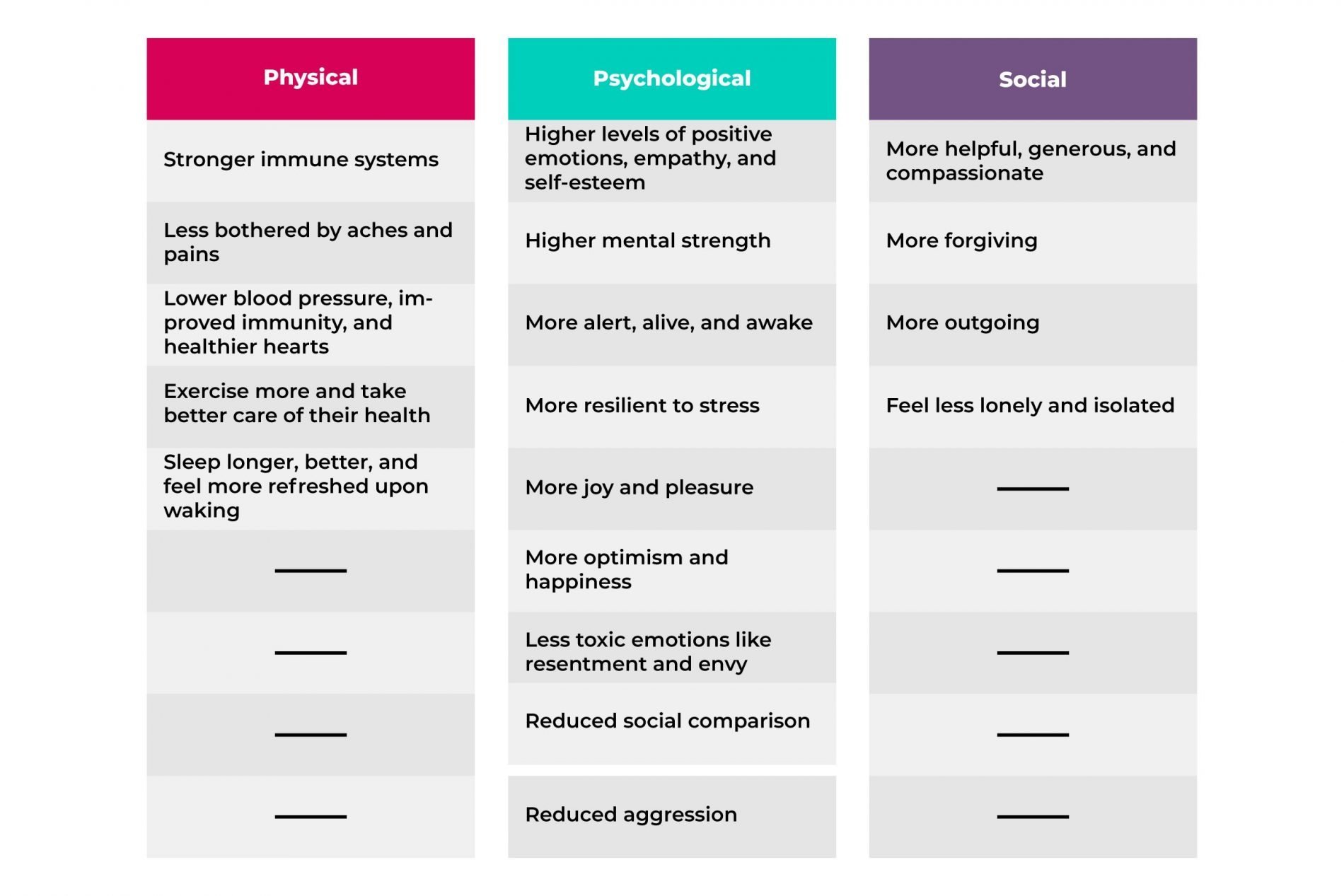
When it comes to the workplace, gratitude has a lot of benefits. And this is not something wishy-washy; all the findings are backed by science.
Gratitude is contagious
Leaders showing gratitude and appreciation has a ripple effect. Scientists proved that cooperative behavior cascades in human social networks, so showing gratitude toward someone is likely to inspire them to thank other people.
Gratitude increases job satisfaction
Research shows people are more satisfied with their jobs when they work in a place that promotes a gratitude culture. Appreciation amplifies and expands in companies, having a positive effect on everyone’s job satisfaction levels.
Gratitude wins you new friends
Two simple words like thank you can have a considerable impact. For example, when you use them on someone, science says you’re providing the other person with the valuable signal that you are someone with whom a high-quality relationship could be formed.
It doesn’t matter whether you thank a stranger for holding the elevator or a colleague for helping you out, acknowledging their contributions can lead you to new opportunities.
Gratitude helps you with social connections
If you want to form and maintain social relationships, gratitude is the multi-purpose ingredient you can’t skip.
Gratitude has a find, remind, and bind function:
- By getting in tune to the thoughtfulness of others, gratitude lets you find people who are good candidates for future connections;
- It reminds you of the goodness in the relationships we’re already a part of;
- It binds you to your partners, collaborators, and friends by making you appreciate them and getting you engaged in behaviors that prolong the relationships.
If you want to learn how gratitude connects to business numbers, decreased turnovers, fewer sick day, and more productivity, this video is for you:
The challenges of gratitude
Gratitude is good, but it's far from easy or simplistic.
What happens when you take the time to count your blessings is almost always humbling. The realization that you are not alone and probably can't make it on your own forces you to acknowledge and give credit to other people.
When you take a closer look at your support system, you feel more responsible for protecting all the good that comes into life and turns gratitude into a motivating emotion.
But maybe one of the most difficult aspects of gratitude is that it challenges our deep need for control and makes us face a daunting reality: we can't always be in charge.
If you still think gratitude is all positive thinking, unicorns, and rainbows, take a look at this video. It will probably change your mind:
Are you a giver or a taker?
To understand gratitude better, you need to know about the kinds of people you might find on a team. This is where Adam Grant comes into the picture again.
Based on values and intentions toward others, he determined people have three interaction styles in companies:
- Takers have a default of “What can you do for me?”. They try to take as much as possible for themselves and avoid giving back unless they really have to. The problem is that they’ll always try to do what’s best for them individually, and not for the people around.
- Givers think in terms of “What can I do for you?”. They enjoy sharing their knowledge freely, they like to mentor, and they’re often looking for ways to contribute to the team. Because their norm is generosity, they’re willing to help, even when they don’t get anything in return. Since they share information freely, givers pave the way for creativity and innovation.
And while givers tend to sacrifice themselves, they always make their teams and organizations better.
- Matchers are trying to strike a balance between giving and taking, trading favors evenly. It’s a classic quid pro quo. And since they have such an appetite for fairness, you’ll often see them learning, teaching, and collaborating effectively.
For more details on this fascinating classification, watch Adam’s 2016 TED talk, where he explores what it takes to build a culture of productive generosity:
The makeup of a team will largely determine their success. As Adam puts it:
“We have a huge body of evidence -- many, many studies looking at the frequency of giving behavior that exists in a team or an organization -- and the more often people are helping and sharing their knowledge and providing mentoring, the better organizations do on every metric we can measure: higher profits, customer satisfaction, employee retention -- even lower operating expenses.“
If you’re interested in learning if you’re a giver, a taker, or a matcher, take Adam’s test for free. All you have to do is give the answer that comes naturally to you for each question. But remember, your results will only be as accurate as you are honest—and self-aware.
Once you know your type, you’ll have a better indication of how easy setting up or adapting to a culture of gratitude will be for you.
Eight proven ways to show appreciation at work
Now that you understand what gratitude is and how transformative it can be for your professional life, let's look at eight science-backed strategies to nurture it in your company.
1. Ask for help
As counter-intuitive as this might sound, asking for help is the best way to kickstart a culture of gratitude.
Remember the giver-receiver-matcher classification? Here's how it plays out:
“Help-seeking isn't important just for protecting the success and the well-being of givers. It's also critical to getting more people to act like givers because the data say that somewhere between 75 and 90 percent of all giving in organizations starts with a request. But a lot of people don't ask. They don't want to look incompetent; they don't know where to turn; they don't want to burden others. Yet if nobody ever asks for help, you have a lot of frustrated givers in your organization who would love to step up and contribute, if they only knew who could benefit and how.“
Adam Grant in his 2016 TED talk
What's more, if you're in an environment where it's safe to ask for help, you feel more supported, appreciated, and less inclined to leave. And all these fuzzy feelings lead to higher morale and overall, more happiness in your life. Amazing, right?
2. Change your definition of success
It's in your power to change the way you define success. You can let go of the narrative where it's all about winning a competition, and instead, focus on your contributions. The most meaningful path to success might be helping others succeed.
You can start by setting some metrics. Consider these questions:
- How intensely do I show my gratitude at work?
- How frequently do I express gratitude at work?
- For how many circumstances in my professional life, do I feel grateful?
- Toward how many different people in my office do I feel thankful?
Give yourself a score from 1 to 10 for each of these questions. Little by little, work on increasing your numbers.
Make sure you know your boss, mentor, and coworkers about this, so you can be helped and held accountable. You'll be starting a ripple effect in no time!
3. Count your blessings
This practice originating in the field of psychology came to be widely known as gratitude journaling. In this specific case, it involves writing five things you're thankful for at work weekly.
Sure, this will put you in a good mood, but take it one step further and make someone else's day. If a teammate is on your gratitude list, let them know about it. Share your appreciation!
4. Three good things
If you want to count your blessings with more intention, this one’s for you. Here’s the process:
- Step 1: Take some time at the end of a day to reflect on everything that happened to you since you got to work.
- Step 2: Describe three things you are grateful for.
- Step 3: Identify what caused them.
For example, if you’re grateful for a ping-pong table you have at work, it might be there because someone in HR wanted to encourage breaks and improve morale. So, drop them a thank you note, even if it feels very out-of-the-blue. It’ll do the job and put a smile on their faces.
Now, the original format of this exercise encourages you to do it daily. But if you keep reading, I’ll tell you all about the research that proved that more isn’t necessarily better when it comes to gratitude.
5. Mental subtraction
Mental subtraction is another variation of the counting blessings strategy. All you have to do is imagine the course of your life if some positive professional events had not occurred.
You’ll achieve what researchers call the George Bailey effect, after the protagonist in the 1946 movie It’s A Wonderful Life.
This exercise forces you to dig deep and reveals critical moments and influential people for your professional life. Reach out to the ones involved and let them how much they’ve helped you.
6. Want what you have
The purpose of this exercise is to identify and appreciate the good that’s already in your life.
Here’s how it goes:
- Step 1: Identify one less-than-grateful thought. For example I’m jealous John was put in charge of the new account.
- Step 2: Come up with some grateful, supportive arguments to counter this idea. In the spirit of our example, it could be something like: I am thankful for the skills I have and put to good use with the clients I already manage.
- Step 3: Meditate on your supportive argument.
- Step 4: Translate that positive inner feeling of appreciation into action. To wrap it up with our example: try thinking about your current position and what you can do to further your growth and development to get assigned bigger clients in the future.
This approach centers you, puts an end to unproductive comparisons and helps you understand you’re in charge.
It can be hard work, but it surely pays off.
7. Gratitude visits
Gratitude visits are pretty simple yet fun and engaging.
If your circumstances allow it, instead of sending an email or an instant message, go directly to the person you’re thankful, and express your gratitude out loud. This works great, especially in circumstances where you feel you haven’t properly thanked the person in the past.
8. Keep a surprise log
Record events that are unexpected or surprising. Most of the time, they turn out to be excellent sources of gratitude.
What’s more, this kind of log can lift your spirits on not-so-happy days, reminding you of all the good that you’ve experienced and will keep experiencing in your life.
How to express your gratitude at work
After uncovering eight strategies for nurturing appreciation, it's time to discover the best ways to show your gratitude at work.
Here are some science-backed tips for you:
- First, check in with yourself. Don't force yourself to feel all grateful when you're in a rush or upset over something.
- Don't just go through the motions. Make a conscious decision to become happier and more grateful. Think about how you'd like the recipient of your gratitude to feel afterward.
- Be honest. We can all tell when praise isn't honest. Don't make a fool of yourself and only express your sincere feelings.
- Make your gratitude specific. Instead of listing a bunch of superficial reasons for which you think you are grateful, focus on one particular thing, and elaborate it in detail.
- Don't assume it goes without saying. You might think that positive feedback on a job well-done implies you're thankful for someone's work. Without being transparent and saying thank you, the other person won't hear or feel your appreciation.
- Be consistent. When you're in a management or leadership position, pay close attention to your habits. If you offer your thanks inconsistently and only to some people, it will look like bias and favoritism.
- Acknowledge and adapt to various preferences. Not everyone has the same preferences, so take your time to discover how the person you're grateful to would like to be recognized. For some, it might be a large company meeting; for others, an email.
- Pay it forward. Don't give kudos only to people you know have reasons to be grateful to you. Share your appreciation with someone who doesn't expect it.
- Don't treat it as a one-time thing. You'll never be able to build your gratitude muscle if you don't use it often. Stop waiting for special days or extraordinary opportunities to show you care.
Sometimes, we hold back on our appreciation because we don't want to make the receiver feel awkward. But people rarely tend to feel this way. And that's because we all love to feel appreciated.
To get over this, put yourself in the recipient's shoes. Even if they feel uncomfortable for a minute, the joy of it will trump it all.
Sprinkling gratitude versus chunking it
I’ve been getting you all excited about gratitude, and maybe now you’re ready to express it several times a day. Well, not so fast. Let’s take a look at what science has to teach us.
In his interview on the Hurry Slowly podcast, Adam Grant shares a little story. When working with live audiences, he often asks people how they’d go about gratitude. Given a chance, would they express it every day, or chunk it and dedicate it some time once a week?
Before we continue, take a moment. How often do you think it’s most beneficial for you to express your gratitude?
Ready? Great.
Almost 80% of people tell Adam they’d sprinkle their gratitude, devoting time each day. Maybe this was also your reply.
But research shows us that more isn’t always better. In a study of gratitude journaling, Sonja Lyubomirsky discovered that people who tracked their gratitude once per week are happier after six weeks. Those who did it three times per week were not. Quite the twist, huh?
Chunkers reap the most happiness from their giving, while sprinklers ended up overwhelmed and burnt out.
For more details on her research, watch Sonja:
Sprinkling gratitude can be nothing more than a drop in the ocean. But chunking it puts you in the driver’s seat, so:
- Pick a day of the week;
- Schedule time in your calendar for appreciation;
- Be deliberate about your gratitude efforts;
- Get ready to turn someone’s day around.
Sure, adapt your gratitude practice to your life and activity field, but try chunking it as much as possible.
Delaying your kudos is OK
Imagine this scenario: you ask someone for advice. You get it, thank for it, then move on with your day. Some time goes by, and you finally follow that recommendation. Everything goes great, and you remember your adviser fondly.
Do you get back to the person to share how everything worked out in the end?
If you’re like most people, your answer might be no. And that’s something you might consider changing.
On Hurry Slowly, Adam Grant says this type of delayed gratitude is actually more fulfilling for the person advising than a quick thank you. Learning how everything unfolded and what role they ended up playing is more rewarding than knowing just a chapter of the story.
So, thank people who help you out right away, but also remember to let them know when their guidance starts making an impact.
How to create a culture of gratitude with Mirro
While it can be easy to start a gratitude journaling practice for yourself or to send thank you notes to your close friends, things might not feel intuitive when it comes to showing gratitude at work.
You can’t build a culture of appreciation by yourself; you need all the help you can get. And that’s precisely why we’ve created Mirro, a radically simple continuous performance management software.
There's no heavy lifting for you to do with all the structures for gratitude baked right into the product.
When using Mirro, wins are no longer lonely victories:
- You get to give kudos to people you work with and make them feel seen and appreciated.
- You can show your appreciation publicly or privately for anyone in the company, and tie it to things like OKRs, work anniversaries, or personal achievements.
- You also learn all about what makes you a valuable team player.
Bogdan Ionita is Mirro's Product Manager. For the past years, he's been in the privileged position of working both with and for Mirro. If you want to learn all about the gratitude hurdles Mirro can help your team overcome; he's your guy:
"I feel very fortunate to be working in an environment shaped by Mirro's mission and values. I love taking ideas and turning them into reality, all with a can-do attitude. Seeing everything come together and knowing how my efforts make an impact is exhilarating to me.
But, far too many times, we're rushing, jumping from one task to another, not taking the time to be in the moment, or to enjoy the process. Milestones go unnoticed, apathy sets in, and we fall into routines where saying thanks is the last thing on our mind. I believe this is a pattern we should break, and Mirro helps us do just that.
Now I can show my appreciation for my teammates, offer encouragement, and point out all the progress we're making.
By laying down the foundation for a culture of feedback and recognition, Mirro gets people on the same page, eliminating adversarial attitudes. We're banking it all on alignment, openness, and growth. And this invites gratitude in naturally, sometimes right from the get-go."
If you want to make gratitude part of your habits at work, ask for a demo of Mirro today.
The snowball effect of gratitude
Simona Lapusan is the founder of Mirro, and she's been a manager for over 18 years now. She's seen first-hand all the benefits of encouraging and nurturing a culture of gratitude in a company.
And she knows just how impactful our employee recognition software can be:
"When people say thank you and give public recognition to their colleagues, it creates a snowball effect where more and more people start sharing their gratitude. This kind of positive acknowledgment has a powerful impact on every individual and can fuel them for a long time.
What's more, even the simple act of saying thank you can make people feel seen and appreciated. And from such a place, they can then be calmer, more positive, and focused on everything that's in their control, performing better.
Recognizing our teammates' efforts and achievements creates a safe space where they will ultimately feel secure enough to experiment, adapt, and innovate."
Laying the foundation of appreciation and gratitude at work is worth it. And once you commit to it, benefits are quick to follow:
"Each month, I have conversations with our new hires. I like to know how they're adjusting and get clues on how to make our onboarding process even smoother.
People tell me all the time they're impressed to see their teammates so supportive and willing to help. They're always trying to improve themselves and to inspire others to grow as well.
I think this is a direct result of us practicing gratitude and recognition as a team, and I couldn't be more thankful for this!"
Simona Lapusan, Mirro Founder
If we've inspired you and you'd like to have such a place for gratitude and appreciation for your team, consider Mirro. We're here to support you each step of the way.
It’s your turn to show some love
Congrats on taking in all this information! I hope you now feel better equipped to practice gratitude and appreciation at work.
Now it’s time to step into the limelight and share everything you’ve learned so far!
- Discover whether you’re a giver, taker, or matcher;
- Schedule time in your calendar for gratitude at least once a week;
- Don’t shy away from asking for help;
- Incorporate gratitude and appreciation into your definition of success;
- Exercise expressing your gratitude on the regular;
- Start a much-needed conversation with your manager and your team about gratitude. You can always send them the link to this article for frame setting.
If you’re willing to model gratitude and appreciation behaviors, others will get inspired and follow your lead.
In case you need more guidance or have any questions, leave me a comment below, and I’ll get back to you.
I appreciate you for your curiosity and your growth mindset, and thank you for reading!




